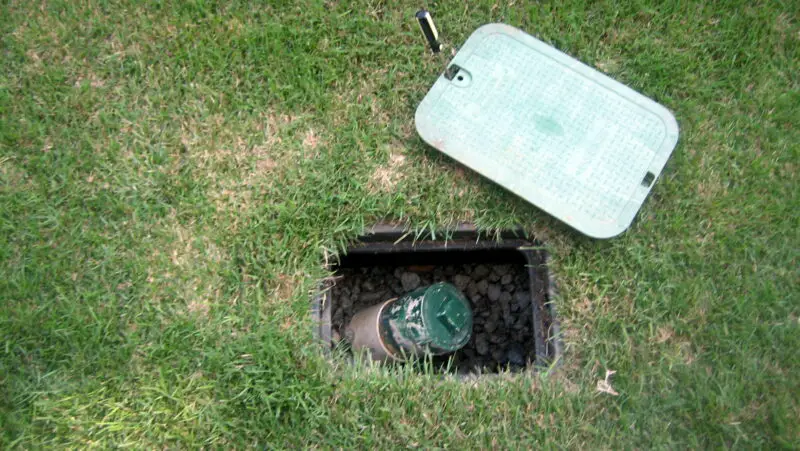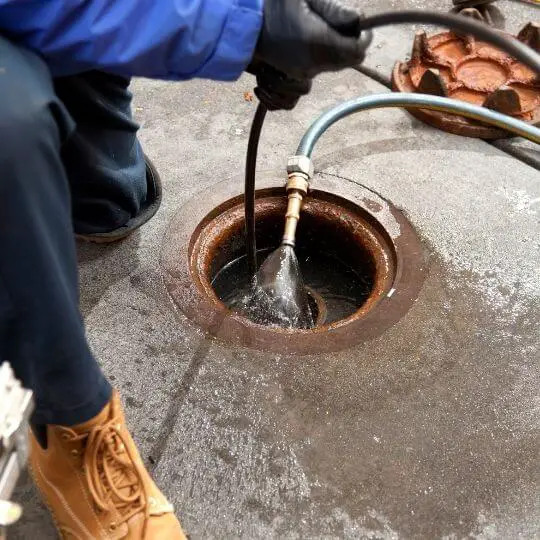Should a sewer cleanout have water in it? This probably came to your mind when you removed the cap.
A sewer cleanout is an important component of any sewer system. It is a pipe that connects to the main sewer line. Its primary purpose is to provide a quick and easy access point to the main sewer line to clear any clogs or debris that may obstruct the wastewater flow.
It is also used to inspect the interior of the sewer pipe, allowing for the detection of any potential problems. Inside the cleanout is a cap with a removable plug. Once the pin is removed, access to the sewer line is provided.
Most sewer cleanouts are in the yard, but some may be in the basement or crawlspace. They are typically made of PVC or cast iron and capped with a threaded plug or a threaded cap. Without a properly installed and maintained sewer cleanout, a sewer system is prone to clogs, overflows, and other problems that can be costly and difficult to fix [1].
The presence of water in a sewer cleanout is a sign that there is a potential problem that should be addressed. This article will discuss why a sewer cleanout should not have water in it, what causes water to be present in a cleanout, and how to address any water issues.
Why You Need Sewer Cleanouts

If there is a clog inside a sewer line, waste material most likely causes it. Other concerns, like improper venting, tree roots, and septic system troubles, could be the cause.
Most motorized sewer augers can clear the most obstructions from debris. However, the auger cannot be used on the toilet or a fixture drain.
The large auger may break toilet porcelain or drainpipes. A sewer cleanout is therefore required. In most homes, the lateral sewer line connects the home’s sewage line to the home’s septic tank or the primary municipal sewer line.
The lateral sewer line frequently has several cleanouts. Somewhere along the lateral line, you can discover one or even two cleanouts and others outside the house [2].
You’ll likely discover several cleanouts in the basement or crawl space in locations that receive extremely cold temperatures to prevent freezing. Cleanouts are commonly strategically located for easy access to any part of a sewer system.
Cleanouts make it is easier to insert a sewer auger and reach the blockage downstream. A drill wouldn’t move upstream if the obstruction were upstream of the cleanout.
Therefore you would need to gain access from a different sewer cleanout. The majority of sewer systems have numerous cleanout fittings for this reason.
Should a Sewer Cleanout Have Water in It?

The sewer cleanout should not have any water. Water in the cleanout could indicate a serious issue with your plumbing system.
If water is present in a cleanout, it likely means there is a blockage or leakage somewhere in the system. It can cause major problems, such as a sewage backup, which can cause health risks and costly repairs.
The blockage could be caused by various things, including roots from nearby trees, clumps of dirt and debris, or even a collapsed pipe. In some cases, the clog can be cleared with a hydro jetting tool, a snake, or other specialized instruments to disperse the clog and efficiently run your waste system.
In other cases, more extensive repair, such as replacing a section of pipe or performing a full sewer line replacement may be necessary. It could also be caused by a cracked or broken pipe or even a joint or fitting that has come loose.
If a leak is suspected, it is important to have a professional inspect the line and make the necessary repairs. It is important to remember that a sewer cleanout should never have water. If water is present, take measures to identify and address the issue.
Another cause of water in a sewer cleanout is the presence of a sump pump. A sump pump is typically used to collect and remove any water that enters a basement or crawlspace. If the sump pump is connected to the sewer line, it can cause water to enter the cleanout pipe, leading to a wet and messy situation.
What Causes Water in a Sewer Cleanout?
There are several possible causes of water in a sewer cleanout. The most common cause is a blockage in the plumbing system, which various things, such as tree roots, grease, and foreign objects, can cause.
A leak in the plumbing system can also cause water to be present in the cleanout. If the water comes from the cleanout itself, it could indicate a problem with the seal around the cap.
If the seal is not tight, water could leak out of the cap. This could be due to a loose cap, or it could be due to a damaged seal. In either case, it is important to have a professional check the seal and replace it if necessary.
In case the water is not coming from the main drain line or the cleanout itself, it could come from a different source. This could be a leak in the pipe or a blockage in the line. It is important to have a professional check the line for any potential issues.
Signs Of Problem In The Sewer Cleanout

- Slow-Draining Sinks and Toilets
When sinks and toilets in the home take longer than usual to drain, it is usually the first sign of a problem with the sewer line. A clog or blockage could cause this in the pipe, preventing the water from flowing freely [3].
- Water and Sewage Backups
Another sign of a problem with the sewer line is water backing up in the sinks, toilets, or bathtubs. Also, if sewage is coming up from the drains or the ground outside, it is a sign of a serious problem with the sewer line.
- Foul Odors
If a bad smell comes from the drains or the yard, it could indicate a problem with the sewer line, especially a clog or blockage in the cleanouts. The clog could be caused by items flushed down the toilet, such as paper towels, feminine hygiene products, or diapers. It could also be caused by tree roots that have grown into the sewer line and are blocking the water flow [4].
Read Also: Best Root Killer For Sewer Lines
How to Address Water in a Sewer Cleanout

If you find water in your sewer cleanout, you should address the issue as soon as possible. The first thing is to locate the source of the water. This can be done using a sewer camera to inspect the plumbing system. If a blockage is found, it should be cleared as soon as possible.
If roots from nearby trees cause the blockage, a professional can be hired to clear the line. If a collapsed pipe causes the backup, then the pipe will need to be replaced. If a leak is the cause, the pipe or joint will need to be repaired or replaced.
Another possible solution is to install a backflow valve. This valve will prevent water from entering the cleanout in the event of a backup. In addition, the line should be inspected for any cap and seal issues before installing a backflow valve.
If it is found, it should be repaired or replaced immediately. It is also important to note that only a professional should install the backflow valve. Furthermore, it is important to have your sewer cleanout regularly inspected to ensure it is functioning properly.
If it is clogged or blocked, it can cause major damage to your home or property. A regular inspection will also help to identify possible problems before they become too serious.
Preventing Problems with the Sewer Cleanout
The best way to prevent problems with the sewer line is to take proactive steps to keep it clear and free of blockages. First, ensure that items such as paper towels, feminine hygiene products, or diapers are not flushed down the toilet.
Another step is to inspect and maintain the cleanout, which is the access point for the sewer line. Cleanouts should be kept free of debris and regularly checked for any signs of damage or clogs.
A professional plumber should carry out the inspection. Finally, it is important to avoid using chemical cleaners, which can damage the pipes and cause clogs [5].
Read Next: Sewer Cleanout Cap Popped Off
Conclusion
A sewer cleanout is an important component of any sewer system and should generally be dry and free of water. A properly installed and maintained sewer cleanout can help prevent costly and difficult repairs.
The presence of water in a sewer cleanout is a sign of a potential problem and should be addressed as soon as possible. Having a sewer cleanout is especially important if your home is located in an area that is prone to flooding.
A cleanout can act as a safety valve allowing water to flow out of the line rather than backing up and causing damage to your home. Possible solutions include identifying and clearing blockages, replacing pipes and fittings, and installing a backflow valve.
In addition, a homeowner can help ensure that their sewer line remains in good working order by taking the necessary steps to address any issues with the sewer cleanout.

Michael Davis is a heating & plumbing expert who currently works as independent contractor in SC. He also writes for Plumbertip.
For almost 10 years he worked on various plumbing tasks across South Carolina.


